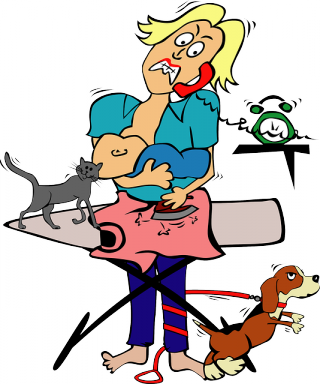Chronic Pain
Multitasking + Chronic Pain and Illness = Bad Idea!
When you are sick or in pain, try to do one thing at a time.
Posted September 7, 2015

This isn’t the first time I’ve written about multitasking; in fact, I talk about it in all three of my books. I recommend against it in general, but particularly for those of us who suffer from chronic pain and/or illness.
I want to share a story about how I recently put my relationship with multitasking to the ultimate test…and failed miserably. As a result, I’ve resolved anew to find ways to cut back on this well-engrained habit.
My story takes place this past July when, innocently enough, I turned on the TV to watch a tennis match at Wimbledon.
As some of you know from my book How to Be Sick, I became a tennis fan when I got sick and was confined to a studio apartment in Paris for three weeks. The French Open was on. It’s one of tennis’ four Majors as they’re called (the other three being The Australian Open, The French Open, and the U.S. Open). Tennis was the only program I could understand on French TV, so I watched a lot of matches.
Since then, I always watch tennis when the Majors roll around. I’m fortunate to have a DVR, which makes it possible for me to record a match that starts at 4 a.m. my time and watch it at my leisure during the day. (Sometimes I have to avoid news websites so I don’t find out the outcome before I’ve seen the match.)

This particular day—my watershed moment with multitasking—I turned on the TV to watch Serena Williams’ match against a little-known player from England, Heather Watson. Tennis fans everywhere were keeping track of Serena’s matches at Wimbledon because, if she won the tournament, she’d have the distinction of holding all four Major titles at the same time.
No one thought the young Brit had a chance against Serena, that is, until Heather Watson won the second set and went up two breaks in the third—and deciding—set. Suddenly, this was the match to watch. It’s the kind of thrilling match we tennis fans wait for. In fact, I often don’t care who wins. I just like the excitement of a close and well-played match.
This must sound like the perfect set up for me to have a good time.
But I didn’t. Why? Well, I had an article I’d been working on for several weeks. Even though there was no deadline for me to finish it and even though I’d turned on the TV specifically to watch this match, I picked up a hard copy of the piece and started editing it. When I finished an editing pass—with the tennis still on TV—I entered my written changes into my computer, printed the piece out and then checked my changes against the previous version.
The problem here is that, unless one possesses superpowers, it’s impossible to simultaneously be looking at a TV and either the hard copy of a piece or a computer screen! So, what did I do? It’s embarrassing to admit, but here goes.
As I edited, I listened to the TV commentators call the match. When I’d hear them shout, “Spectacular shot!” or “How did she ever get to that ball?” or “Unbelievable point!”…I’d pause the DVR, rewind to before they’d made the declaration and then watch what they were referring to.
Then, I’d let the match continue, while I looked back down at the hard copy or at my computer screen, struggling both to find my place in the article and to switch my attention back to the subject I was writing about. Then, the next time I heard something like “What a point!”...I’d do the same thing.
Here’s what my experience was like:
- I did not enjoy the tennis match. I was never able to get into the flow of the match or into the emotional intensity that both players were feeling. In addition, when I rewound to watch those spectacular points, I didn't experience the joy of being surprised, because I knew what was about to happen.
- I did not enjoy the writing. Just as it was hard to get into the flow of the tennis match, it was hard to get into the flow of the article because, as soon as I'd focus my attention on it, I’d have to stop, rewind the DVR so I could watch the “spectacular” point, and then try to find the place in the piece where I’d left off. I didn’t enjoy it and, what’s more, it was mentally exhausting.
- It took me twice as long to watch the tennis match because of all this pausing and rewinding. It’s hard enough with my illness to watch tennis at all (trying to follow the “back and forth” of the ball can be fatiguing), and now my little “stop and rewind” routine had dragged the match out for hours.
- I was irritated and cranky because the tennis kept interrupting my writing and the writing kept me from enjoying the tennis. I’d done a great job of making myself miserable!
- I was (to use our household word for it) trashed afterward. When I tried to take my midday nap, my physical symptoms had been so exacerbated by this crazy multitasking scheme that I wasn’t able to get my body to calm down and rest; as a result, I felt awful the rest of that day and the next day too.
This experience convinced me more than ever that multitasking rarely mixes well with chronic pain and illness. Sure, some multitasking works okay: eating a snack while reading or watching TV. But when activities require concentration in order to do them well or even enjoy them, I’ve resolved anew: one thing at a time.
Now, if you’ll excuse me, I have to put my computer down because the U.S. Open is on, and If Serena wins, she’ll hold all four Major titles in the same calendar year, a feat so rare in tennis that it’s called the Grand Slam.
Update: Four days after I posted this, Serena was beaten in the semifinals by an unseeded Italian player, Roberta Vinci, who until that day was mostly known as a doubles player. Now she'll be known as the player who stopped Serena from winning the Grand Slam.
© 2015 Toni Bernhard. Thank you for reading my work. I’m the author of four books:
How to Be Sick: Your Pocket Companion (for those who've read How to Be Sick and for those who haven't). May, 2020.
How to Live Well with Chronic Pain and Illness: A Mindful Guide (2015)
How to Wake Up: A Buddhist-Inspired Guide to Navigating Joy and Sorrow (2013)
All of my books are available in audio format from Amazon, audible.com, and iTunes.
Visit www.tonibernhard.com for more information and buying options.
Using the envelope icon, you can email this piece to others. I'm active on Facebook, Pinterest, and Twitter.
You may also like “4 Tips for Slowing Down to Reduce Stress.”




